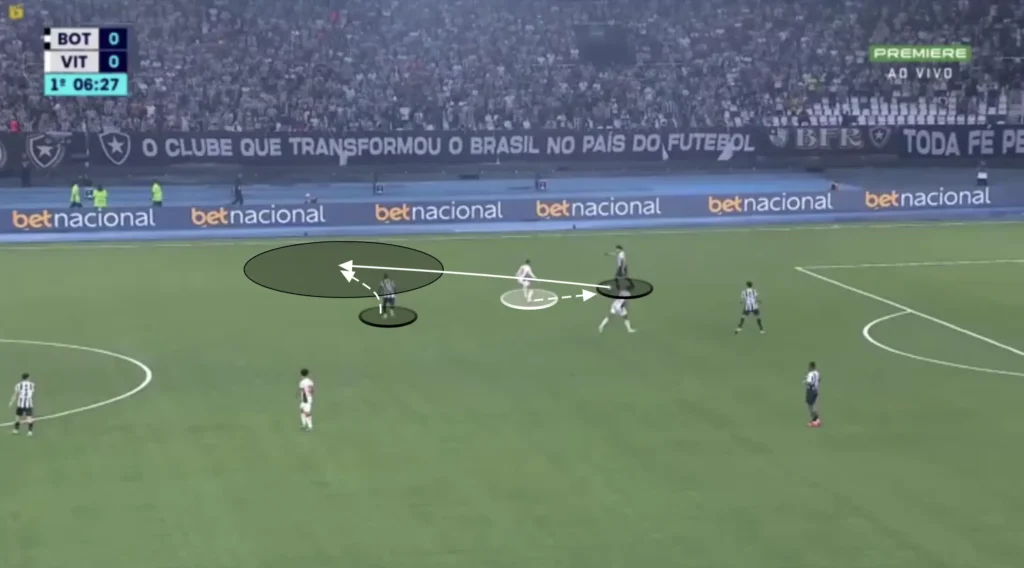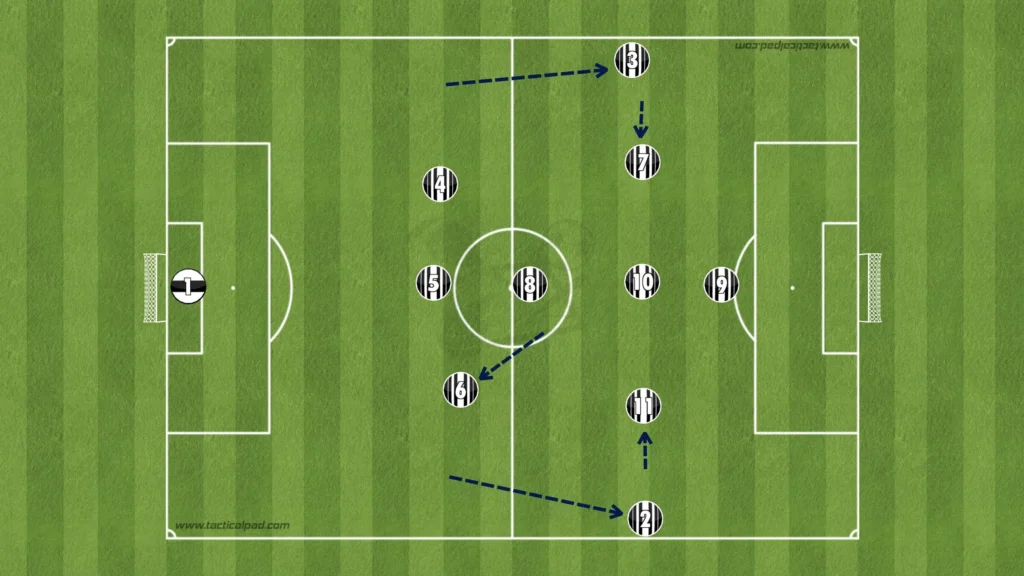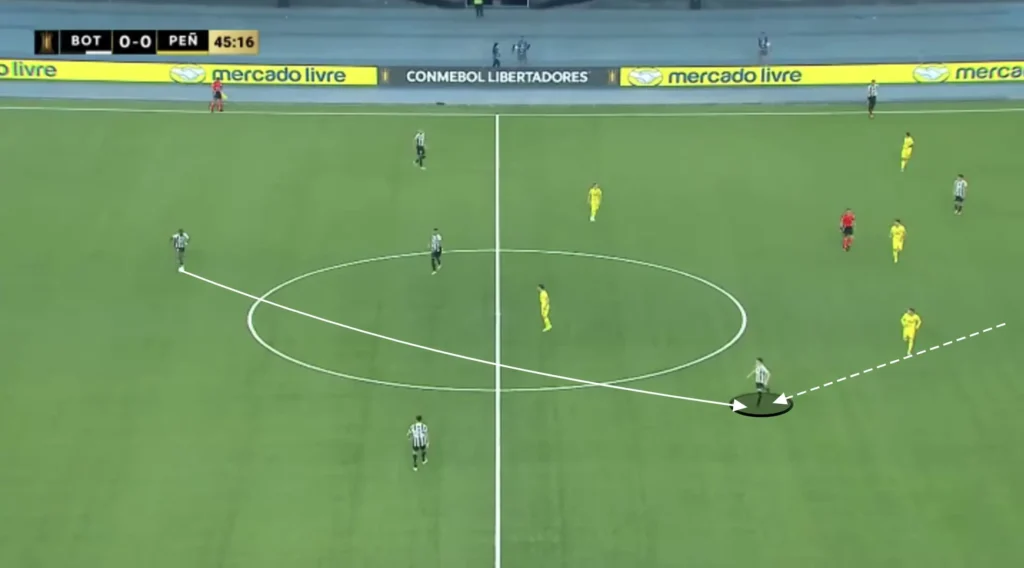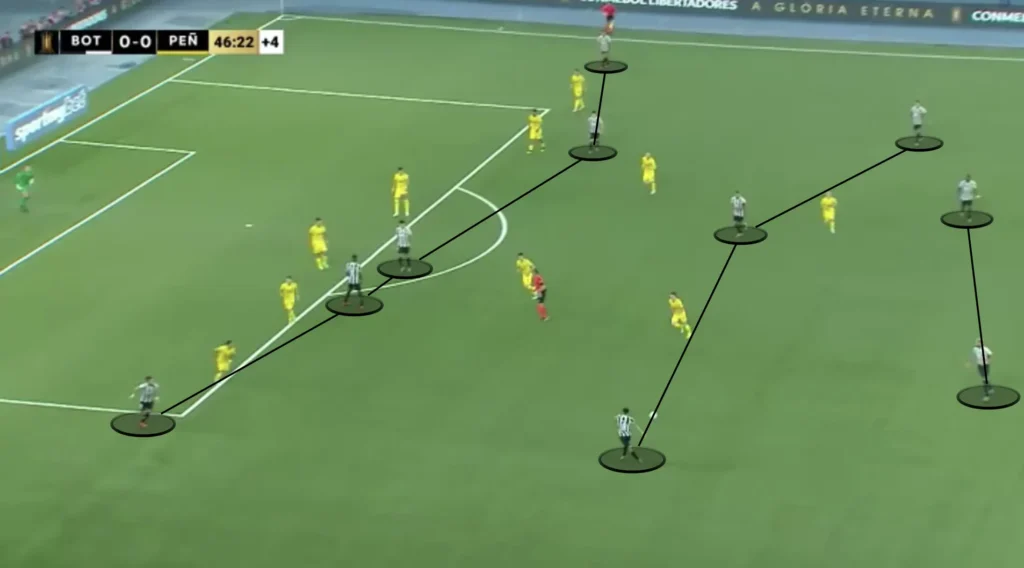Artur Jorge’s tactical approach at Botafogo brings a blend of structure, creativity, and efficiency to the pitch. His system emphasizes balanced possession, sharp transitions, and defensive solidity, creating a style that is both disciplined and dynamic. With a clear philosophy and well-defined roles for his players, Jorge’s Botafogo has developed into a team capable of adapting to different situations while maintaining its identity. This analysis breaks down the key principles, formations, and strategies that define his approach, showcasing how he sets his team up for success.
Build-up
Low Build-up
In the low build-up, Artur Jorge usually sets his team up in a 1-4-2-3-1 formation.


The wingers usually start wide and come into the midfield positions when the play starts.

This often gives Botafogo a numerical superiority in the midfield, which will help them beat the opposition’s press. The wingers also have better conditions to win the second balls when they are in the middle. When the goalkeeper plays a long ball toward the strikers, the wingers and number-ten will work together to win the second ball, which allows Botafogo to establish possession higher up the pitch.

Follow Pressure
A common tool that the Botafogo players use to beat the opposition’s press in the low build-up is to follow the pressure. This means running into the space that a pressing player is leaving behind. When an opposition winger, for example, pushes up to press a Botafogo defender, space opens up behind the winger. A Botafogo midfielder will often run into this space, giving the defender the option to pass him the ball on the outside of the opposition winger.

Other opposition players will rarely follow the midfielder into this space, which allows him to receive the ball, turn, and progress the ball up the pitch.
Build-up vs Mid-Block
When building up against a mid-block, the Botafogo wingers invert into the middle, meaning the fullbacks play a crucial role in providing width and supporting the attack by pushing up the field. When the wingers drift into central spaces, Botafogo’s fullbacks move higher up the flanks to occupy the vacated wide areas, giving the team multiple options in attack.

This positioning allows the fullbacks to either support the midfield with additional passing outlets or to exploit open channels for overlapping runs. By doing so, they draw defenders out of position, opening up space for the inverted wingers or central midfielders to make forward runs.
Additionally, when advancing the ball, Botafogo’s holding midfielders and defenders will often find the attacking fullbacks in the spaces outside the opposition defense with precise through-balls. In these positions, the Botafogo fullbacks will have enough time and space to take the ball forward and cross it into the attackers in the box.

One of Botafogo’s holding midfielders will also drop into the backline when building up against a mid-block. This shift creates a back three, allowing Botafogo to maintain defensive stability while gaining more control in possession.


These rotations effectively put Botafogo in a 1-3-1-5-1 formation.


The back three, formed by the center-backs and the dropping holding midfielder, provides a solid base for recycling possession and resisting opposition pressure. Meanwhile, the attacking fullbacks join the inverted wingers and number-ten to create a five-man line in the middle, offering numerical superiority against the opposition midfield. The advanced fullbacks stretch the field horizontally, creating width and opening passing lanes. The lone striker stays high, pinning the opposing center-backs and remaining a constant goal threat. This fluid setup allows Botafogo to dominate the midfield, exploit wide spaces, and transition seamlessly between attacking and defensive phases.
Numerical Advantages in the Middle
Botafogo will always have many players in the center. Artur Jorge usually has a winger/wingback wide on each side and positions the remaining eight players in the middle.
Having only the two wingers/wingbacks out wide and the rest in the middle creates more options in the center and less space between the players. Jorge likes this because he prioritizes playing through the middle. He needs one player out wide to pull the opposition apart while the rest create numerical advantages in the midfield areas.
When a team outnumbers the opposition in the midfield, it can more easily retain the ball, exploit spaces, and progress the ball through the center. Botafogo will often progress the ball through quick central passes between the midfielders, beating the opposition’s press and exploiting gaps in the defense.
At the same time, having many players centrally builds good conditions in defensive transitions since it allows more players to counterpress when they lose the ball.
Another purpose for keeping many players in the middle is to shorten the distance between them. This shortens the length of the passes, which naturally shortens the time between passes. This means the opposition players will have less time to push up and press, giving the Botafogo players more time and control.
Fluidity
The four central attacking players—comprising the inverted wingers, the number-ten, and the striker—display exceptional fluidity in Botafogo’s build-up play. Rather than sticking to rigid positions, they constantly rotate and interchange roles to create unpredictability and confuse the opposition’s defensive structure.
The inverted wingers often drop into midfield to act as additional playmakers or drift wide to stretch the defense when needed. Meanwhile, the number-ten frequently pushes higher to support the striker or drops deeper to link play. The striker also contributes by dropping into pockets of space, dragging defenders out of position, and creating room for penetrating runs from the other three. This fluid movement ensures that Botafogo maintains dynamism in attack, enabling them to exploit gaps in the opposition’s lines effectively.
Additionally, Botafogo primarily progress the ball by finding an attacking midfielder, who drops between the lines to receive passes from the backline.


Once in possession, this player can turn and drive forward with the ball, drawing opposition midfielders and defenders toward them, which creates space for the inverted wingers or striker to exploit with off-the-ball runs.
High Build-up
In the high build-up(when building up against a low-block), Botafogo usually rotate into a 1-2-3-5 formation with one of the center-backs pushing up into the midfield and an attacking midfielder dropping down next to the holding midfielder.


This 1-2-3-5 shape not only enhances Botafogo’s ability to progress the ball but also strengthens their rest-defence. By positioning three players centrally in the midfield, they create a solid structure to immediately counter any attempts by the opposition to transition quickly after regaining possession. This setup allows Botafogo to sustain pressure high up the pitch while minimizing vulnerability during moments of defensive transition, making it a key component of their tactical efficiency.
High Backline
A massive aspect of Artur Jorge’s high build-up is to have the defenders high up and close to the center. This helps in the counterpress because they get closer to the midfield. Having more players close to the center who can win the ball back makes it difficult for the opposition to do anything when they win possession. Furthermore, the high backline shortens the distance between players, shortening the time and length of the passes and preventing the opposition from pushing up their defense.

Attacking the Half-Space
In the final third, Jorge’s players usually look to create chances by attacking the space between the opposition center-back and fullback. They primarily do this from the wide areas with underlaps from the attacking midfielders. When the Botafogo winger receives the ball out wide, he will attract the opposition fullback. This opens the space between the opposition fullback and center-back, which allows the attacking midfielder to make the underlapping run into this space. The ball can be played to the underlapping player, who can cross the ball into the box or attack his defender in a 1v1 situation.

Additionally, the winger does not have to play the ball to the underlapping player. The run from the attacking midfielder will often drag away an opposition defensive midfielder, which opens the space inside. The winger can take the ball inside and shoot or find a pass to a free player in front of the backline.


Botafogo will also exploit this gap between the opposition fullback and center-back with through-balls to well-timed runs from the midfielders. These incisive movements add an extra layer to the Botafogo offense, making it harder for defenses to stay organized.

Many Players in the Box
Artur Jorge also emphasizes getting multiple players into the box, creating a chaotic environment for the opposition defenders, and increasing their chances of scoring. The attackers and midfielders look to make aggressive runs into the box when the ball is in the final third, often getting four or five players into these areas to create overloads.


The numerical advantages in the box increase the chances of connecting with the cross, as more players present multiple targets for the crosser, making it harder for defenders to mark everyone effectively. Additionally, having multiple players in the box provides options for different types of finishes, whether it’s a header, volley, or a quick tap-in. It also allows for better positioning to react to second balls or rebounds, increasing the likelihood of capitalizing on any defensive errors.
In Botafogo’s attacking system, the wingers/wingbacks score many goals from crosses at the back post. The opposition fullback will often be preoccupied with a Botafogo attacker, which leaves massive space at the back post for the winger/wingback to attack. The winger/wingback can be found directly or indirectly if no one else connects with the cross.

Artur Jorge also positions many players outside the box, ready for the second balls and cut-backs. Botafogo will create many crossing opportunities, which pushes down the opposition’s defense and opens the space in front of the opposition’s backline. The holding midfielders can collect any loose balls or be found directly in these spaces with cut-backs, and from there, they can shoot or combine with an attacker to create goalscoring opportunities.

Defending
Botafogo’s base formation when defending is the 1-4-2-3-1 formation. They look to set up in a mid-block, always trying to close the center and force the opposition out wide.

Defending in a 1-4-2-3-1 formation revolves around maintaining a compact and organized structure. The formation features a back four that provides stability, with two holding midfielders shielding the defense. These holding midfielders play a crucial role in breaking up opposition attacks and providing cover for the fullbacks when they break out of shape. The three attacking midfielders work to stop entries for the opposition and cut off passing lanes, while the lone striker applies pressure on the ball. The team aims to stay compact, forcing the opposition to play wide and limiting their ability to penetrate through the center. By maintaining this structure, the 1-4-2-3-1 formation helps to control the middle of the pitch, making it difficult for opponents to create scoring opportunities.
Work Rate
Botafogo’s work rate when defending is exceptional, defined by relentless energy and discipline. Under Artur Jorge, the team is organized and compact, with every player contributing to defensive duties. The midfield and forward lines press with intensity, closing down spaces and forcing opponents into uncomfortable positions. The Botafogo backline remains focused, consistently tracking runs and maintaining their shape. When a defender breaks out of shape to put pressure on an opposition player, a Botafogo midfielder will always drop into the backline to cover for his teammate. This compactness ensures that the team stays solid defensively, making it harder for the opposition to break through with wide or central attacks.
Aggressiveness
The Botafogo players also defend with remarkable aggression, making it difficult for opponents to find time or space on the ball. Their defensive system relies on intense pressing, with players quickly closing down passing lanes and applying immediate pressure to the ball carrier. The team often shifts into a compact shape, hunting in packs to force turnovers high up the pitch. Artur Jorge encourages his players to be physical and proactive, winning duels and disrupting the opposition’s rhythm. This relentless approach not only recovers possession efficiently but also sets the stage for fast counterattacks.
High Press
Artur Jorge always wants to press the opposition high up the pitch. Their pressing structure will depend on the opposition, but they primarily press with a front three up top, go man-to-man in the midfield, and stay with a back four in the defense.

When pressing against a back four(which most teams build up in), the wingers and striker will be in a numerical disadvantage against the opposition backline, meaning one defender will be open. The three attackers always have to leave the least threatening defender open, usually the defender furthest from the ball.
When one of the center-backs gets the ball, the striker comes up and presses, the ball-side winger pushes up on the ball-side fullback, and the far-side winger comes up to close the pass to the far-side center-back.

The Botafogo winger will press from the inside, closing any passes into the middle. The striker will try to stop the opposition from switching sides by closing the pass to the ball-side center-back, while the Botafogo midfielders will be man-to-man against the opposition midfielders. This gives the opposition fullback very few passing options and often triggers a rushed long ball, which the Botafogo backline usually will win.
Artur Jorge’s aggressive pressing system targets the flanks, where teams are often more vulnerable under pressure. This maximizes Botafogo’s chances of regaining possession and quickly transitioning into attack.
Transitions
Defensive Transitions
Botafogo are great in defensive transitions. In possession, they always have many players high up and close to the ball, which creates good conditions for counterpressing. Many players close to the ball after losing possession means that many players can work towards regaining possession. Artur Jorge’s players are also very aggressive in the first seconds after losing the ball. The four or five players closest will immediately jump on the opposition player with the ball and close the distance to cut off any passing lanes. This approach disrupts the opponent’s transition from defense to attack, forcing errors and creating opportunities to regain control in dangerous areas.


Counterpressing like this keeps Botafogo on the front foot, allowing them to dominate possession and create more scoring opportunities. However, it requires exceptional fitness, tactical discipline, and teamwork.
Offensive Transitions
Artur Jorge also wants his team to counterattack in their offensive transitions. When they win back possession, Botafogo’s players immediately shift into attack mode, looking to exploit any space left by opponents. Their midfielders, especially the pivots, play a crucial role in initiating quick, vertical passes to the forwards or wide players, who are already positioned to make penetrating runs. This rapid transition is often supported by overlapping fullbacks, providing width and stretching the opposition’s defense. With these quick movements, the Botafogo players frequently catch teams off guard, creating high-quality chances before the opponent can regroup defensively. Jorge’s system makes Botafogo’s counterattacks highly effective, balancing directness with calculated positioning to break through defenses with minimal delay.

Additionally, the Botafogo players are great at finding open spaces in the counterattacks. Instead of playing the ball straight forward where opposition defenders may still be positioned, they play a sideways or diagonal pass, allowing the team to bypass pressure and shift the play into open areas. From these areas, the Botafogo attackers can take the ball forward and quickly get past the opposition to create a goalscoring opportunity.

Botafogo also try to involve many players in their counterattacks, creating varied options and making it difficult for opponents to predict the next move. This ensures that Botafogo have plenty of support around the ball and several passing options in transition.
Final Thoughts
In conclusion, Artur Jorge’s tactical approach at Botafogo highlights his ability to blend structure with creativity. His organized defensive setups, fluid attacking movements, and emphasis on transitions showcase a modern, adaptable philosophy. Botafogo thrives on discipline and intensity under Jorge’s guidance, making them a team that’s difficult to break down and dangerous on the counter.
As Jorge continues to refine his tactical blueprint, Botafogo’s performances reflect his commitment to both balance and innovation. His style is not only effective but also exciting, offering fans a glimpse of a team that’s evolving into a formidable force.
